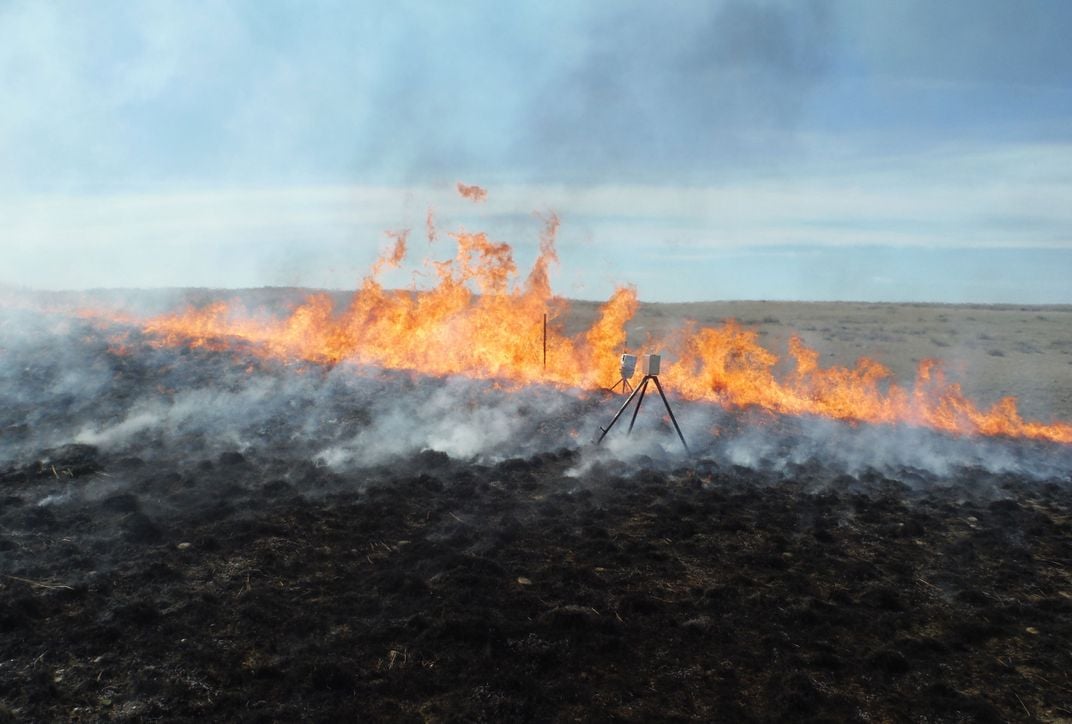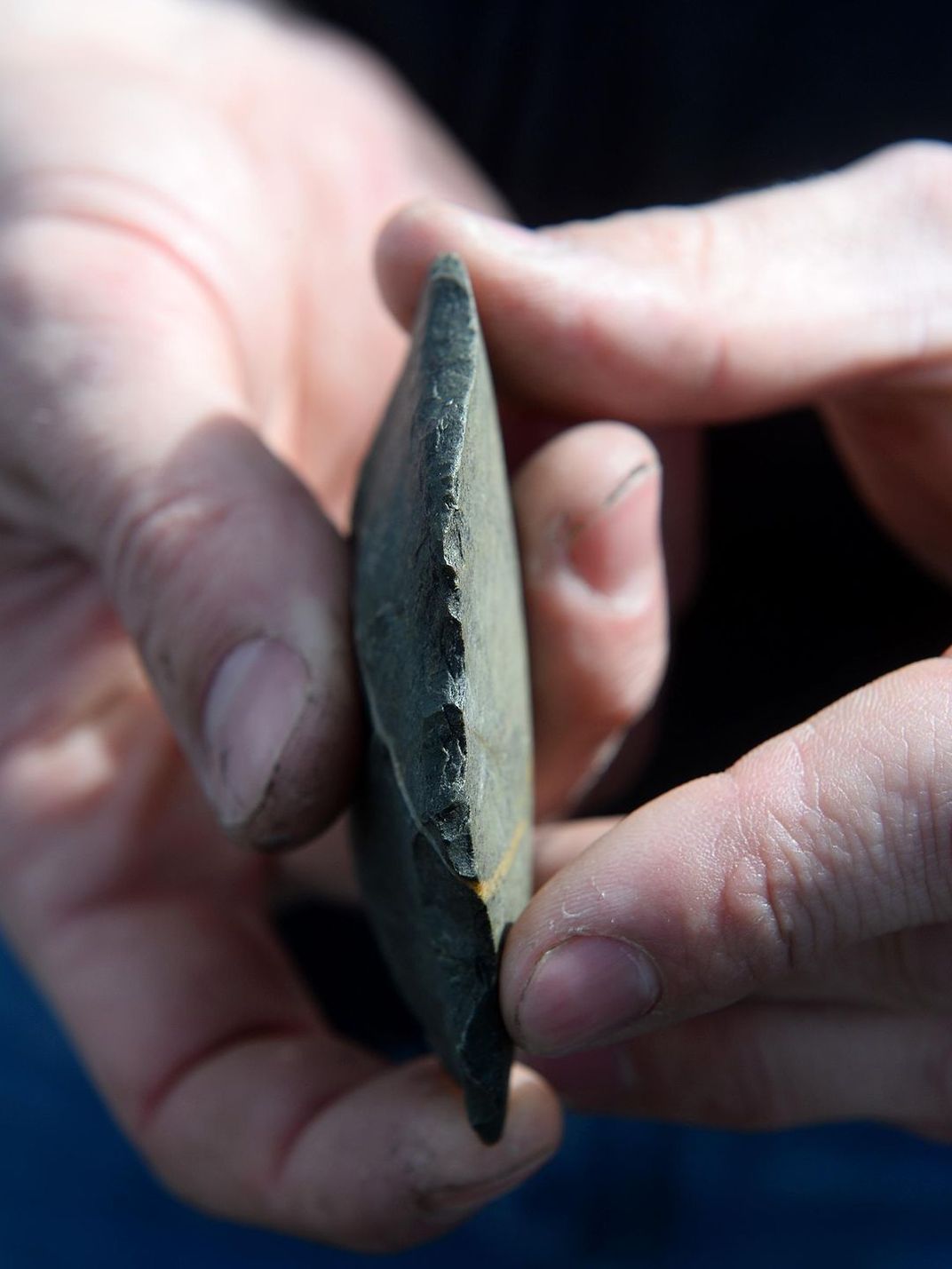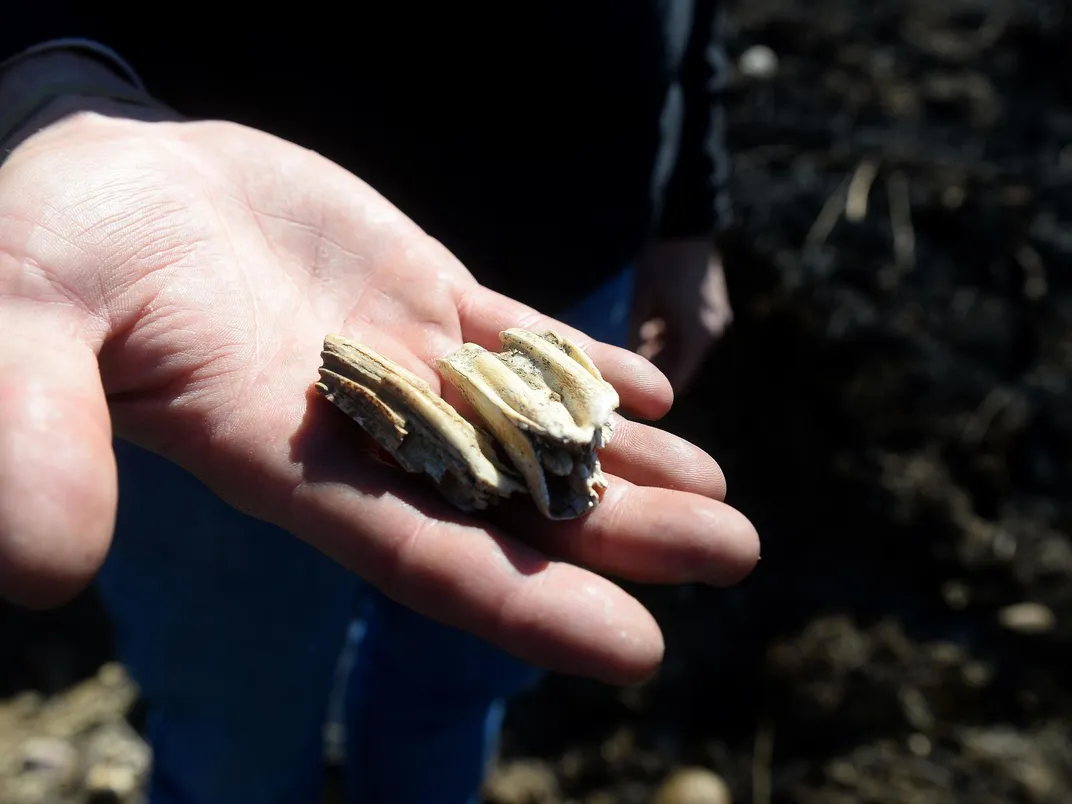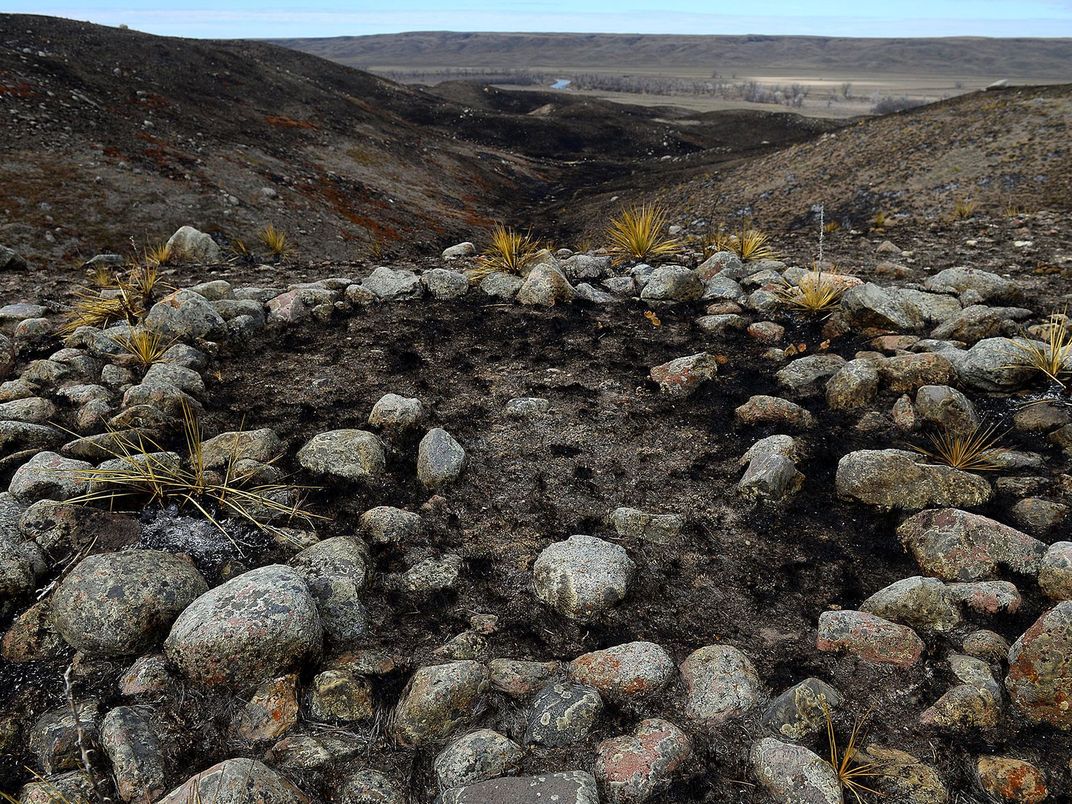Why Archaeologists Are Intentionally Setting Early American Sites on Fire
Archaeologists, who typically consider fire to be a destructive force, are now finding that it can be useful as tool of discovery
/https://tf-cmsv2-smithsonianmag-media.s3.amazonaws.com/filer/46/85/4685d468-038f-4b38-bcfd-a55c2dd8cae7/b9321637486z1_20160406195923_000_gkce07o6r1-0.jpg)
On a sunny day this spring Josh Chase, an archaeologist for the Bureau of Land Management, stood on the bluff above Montana’s Milk River and watched as flames raced through one of the most unique archaeological sites on the northern Plains. But instead of worrying about the fate of smoldering teepee rings or stone tools, Chase was excited. He had planned the controlled burn, and even the firefighters on scene could see the fire instantly uncovering a rich record of the bison hunters who lived there 700 to 1,000 years ago.
By burning the 600-acre stretch of grassland in northeastern Montana named after one-time landowner Henry Smith, Chase gained perspective that would have been nearly impossible to achieve with traditional archaeological techniques. A research aircraft later flew over to image the freshly exposed artifacts, including the remains of rock structures used to corral and kill bison, stone vision quest structures where people fasted and prayed and stones arranged in human and animal shapes.
“Before the fire, if we were looking at the site through a door, we were just looking through the peephole,” says Chase. “Now that we’ve burned it and recorded it, we’ve opened the door so we can see everything there.”
As far as Chase knows, it’s the first time an archaeologist has intentionally set a cultural site ablaze. It’s much more common for archaeologists in the Western U.S. to worry about wildfires--or fire-fighting efforts--damaging a site. But since grasslands are adapted to natural fire cycles, Chase had a rare opportunity to use fire as an archaeological tool. It's a tool that has had surprisingly successful results thus far. Chase is still analyzing the flight data from this year’s 400-acre burn, but an initial burn last spring revealed 2,400 new stone features – about one every three to five feet.
When Chase began working on the Henry Smith site in 2010 realized it was going to be too large to map by hand. Plus, vegetation obscured much of it. He knew grass fires to be a natural part of the plains ecosystem, and most of the artifacts there are durable quartzite stones. To Chase, a former wildland firefighter, a controlled burn seemed like a sensible way to expose any artifacts on the surface without harming them.
Since much of the data about fire’s impacts on archaeological sites comes from studying high-intensity forest fires, Chase wanted to be sure that a low-intensity grass fire wouldn’t harm the archaeological record, especially fragile animal bones. So for last year's 300-acre burn, Chase selected a location with only stone artifacts. Within that burn, a crew from the U.S Forest Service's Missoula Fire Science Laboratory fitted mock stone and bone artifacts with heat sensors and burned test plots in different vegetation types. The fire raced over them for only 30 seconds and left the artifacts unscathed. That gave him confidence that this year’s blaze wouldn’t harm the sensitive bison bone fragments in the Henry Smith site.
Archaeologists have known about the existence of a buffalo kill site there since the 1930s. Arrowheads found at Henry Smith identify it as part of the Avonlea Period, when northern Plains bison hunters first started using bows and arrows. But no one studied it systematically until the 1980s, when a researcher identified two spiritually significant stone effigies, and excavated a buffalo jump. To harvest bison, hunting groups built miles-long lines of rock piles, called drivelines. The drivelines helped the hunters herd the running bison towards a rocky bluff where the animals “jumped” into a ravine by tripping and stumbling.
Henry Smith’s overwhelming density of features including vision quest sites, four more effigies and additional drive lines didn’t come into focus until last year’s test burn. This year’s burn revealed stone tools and teepee rings indicating the site was used for day-to-day living in addition to spiritual and hunting purposes. Chase says that it’s very unusual to find all of those features in one location.
While the site is within the traditional territories of multiple American Indian tribes, archaeologists and tribal members have not yet linked it to a specific one, and the area is no longer used by native groups. Chase notififed 64 tribes throughout the U.S. before the burn and had face-to-face meetings with Montana tribes to gather feedback on the burn technique. No one had a problem with it, according to Chase.
This summer, Chase will have more meetings with the region's tribes to get their perspectives on interpreting the site. He'll also be be doing fieldwork to confirm that his is correctly interpreting the aerial images and he’s now developing hypotheses about the Henry Smith site’s significance.
“I would speculate that it probably started as a very good place to get and process bison, and due to that fact it turned into a spiritual place,” he says. “Now we’re looking at that snapshot in time with all those features from all those years of activity laying on top of one another.”
Fire has also influenced how Larry Todd, an emeritus anthropology professor at the Colorado State University, interpreted the archaeology of Wyoming’s wilderness. Instead of excavating deep into a small area, he surveys the surface for artifacts that provide a big-picture view while making minimal impact on the land. Todd had spent five years been mapping a site in the Absaroka Mountains just southeast of Yellowstone National Park when the Little Venus wildfire burned through in 2006. In the aftermath, he realized that he had been studying a severely watered down version of the archaeological record.
The fire increased the artifacts visible on the surface by 1,600 percent. The vegetation had also hid high-quality artifacts. There were many more bone fragments, fire pits, trade beads and ceramic figurines – the kinds of objects that contain a lot of information for archaeologists.
That changed Todd’s interpretation of the site. He now thinks that Native Americans used Wyoming’s mountains much more intensively and for more of the year than his earlier work showed. “The most amazing thing that the fire has exposed is our ignorance,” he says.
For Todd though, the increased knowledge comes with a cost. Fires expose artifacts to looting, erosion, weathering, and the hooves of free-ranging cattle that “take that beautiful crisp picture of what life was like in the past and make it look like it went through a Cuisinart.”
It pains Todd that he can’t get to every site in time. “When a fire burns through an area, and they are literally some of the most spectacular archeological sites you have ever seen, it’s a real mix of emotion,” he says. “You’re sort of saying, ‘Oh my God this is going be gone, and I don’t have the time, and I don’t have the people, and I don’t have the funding to record it properly.’ It’s thrilling, but depressing at the same time.”
Chase avoided those tradeoffs at Henry Smith because many of its artifacts aren’t fire-sensitive, the site is protected from looters by the private ranches surrounding it, and he had the luxury of planning for a controlled burn. His work will be important to understanding not only the people who lived and hunted there, but also how to protect and study grassland cultural sites after future wildfires or prescribed burns.

Ana Steffen, an archaeologist working at New Mexico’s Valles Caldera National Preserve, has seen some of the worst of what fire can do. In 2011, the Las Conchas fire burned 156,000 acres in the Jemez Mountains and set a new record for the state’s largest fire at the time. The fast-moving conflagration spread at the rate of about two football fields per second, denuding much of the forest.
“What we realized was Las Conchas the worst-case scenario by every measure for archaeology,” says Steffen. “Not only did it burn a huge area, it burned large areas really, really badly with severe direct effects, and with terrible indirect effects later on.”
In the end, the Las Conchas fire affected more than 2,500 archaeological sites. After withstanding centuries of more moderate fires, Ancestral Puebloan dwellings crumbled, pottery disintegrated, and flint and obsidian artifacts shattered. Then flash floods ripped through the bare soils, carrying away 25-acre obsidian quarries used by Archaic period hunter-gatherers.
Steffen is now part of a team trying to make the most out of the Las Conchas fire. Researchers are doing controlled lab experiments to model how archaeological materials respond to a variety of fire conditions. That will help archaeologists and fire managers figure out when it’s safe to do prescribed burns, and how to protect features from wildfire. It will also help archaeologists understand past fire severity when they are looking at a site.
A history of suppressing low-intensity wildfires helped contributed to the Las Conchas fire’s severity, so Steffen applauds using prescribed fire as an archaeological tool. “Being able to return fire to the landscape is a wonderful way of humans interacting with the environment,” she says. “I find it to be very, very healthy. So mobilizing a case study such as this one where you can get archaeologists out on the landscape, where you can see what’s happening after the fire, that’s just smart science.”
There's still a lot to learn by studying how fires affect cultural sites, and researchers have ample opportunity to do that work. For example, on the Shoshone National Forest where Todd works, fires have been getting larger and more frequent over the last 20 years. During one field season the ashes of an active wildfire fell on him as he examined the aftermath of an old one. “There’s a whole suite of really complex interactions going on that are probably going make fire archaeology something we’re going to see more of in the future,” he says.


